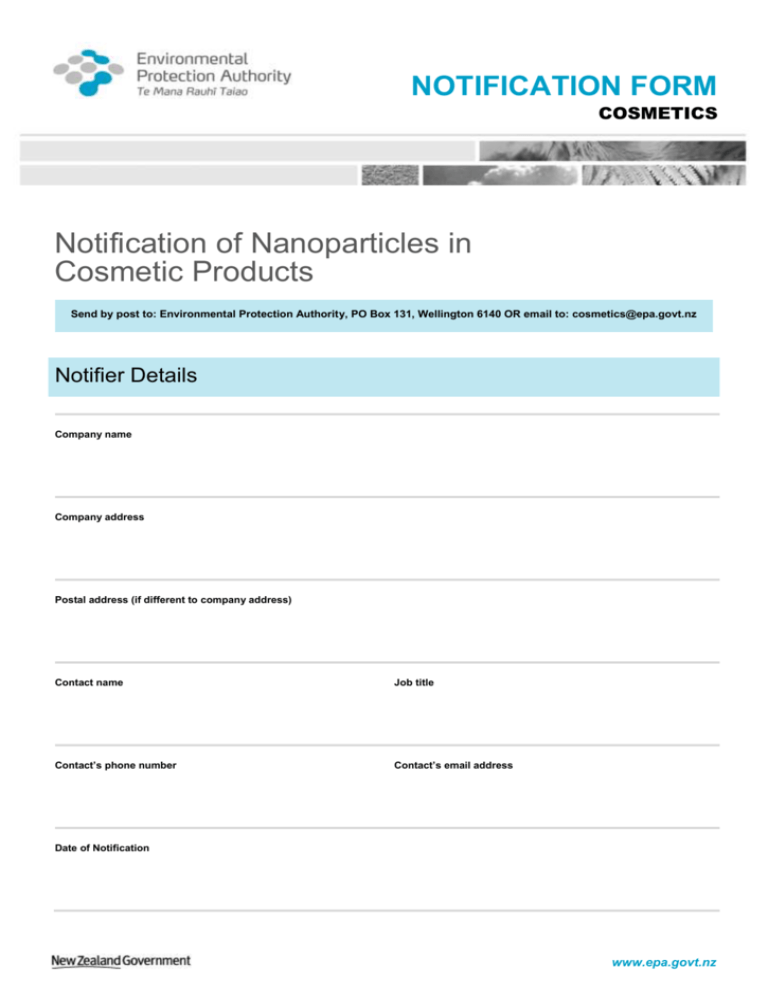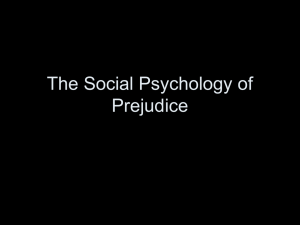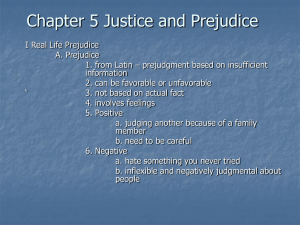Notification of Nanoparticles in Cosmetic Products Form
advertisement

NOTIFICATION FORM COSMETICS Notification of Nanoparticles in Cosmetic Products Send by post to: Environmental Protection Authority, PO Box 131, Wellington 6140 OR email to: cosmetics@epa.govt.nz Notifier Details Company name Company address Postal address (if different to company address) Contact name Job title Contact’s phone number Contact’s email address Date of Notification www.epa.govt.nz 2 Notification of Nanoparticles in Cosmetic Products Nanomaterial Information Name of nanomaterial: CAS number (chemical abstracts service registry number) of nanomaterial: [Please check that the CAS number matches the name of the chemical. A useful website for checking these details is ChemID Plus http://chem.sis.nlm.nih.gov/chemidplus/. If these details don’t match, we will need to ask you for more information i.e. to confirm whether the name or the CAS number is correct. If the chemical does not have a CAS registry number please explain why not.] Product Information Product name : [This is the trade name of the product which contains the nanomaterial.] What is the product used for: [Please be specific e.g. roll-on antiperspirant, shower gel etc] What is the concentration of nanomaterial in the formulated product: Function of nanomaterial: Please attach a Safety Data Sheet for the nanomaterial if you have one. Confidentiality The EPA intends publishing the company name, product name and type of nanomaterial contained in the product on its website as a matter of course. Please advise if you consider this information to be confidential and do not wish it to be published on the EPA’s website: Yes If you answer “yes” to this question, please attach a justification document. See “Justifying the with-holding of confidential information” overleaf for guidance. Please note that the EPA may also be asked to release this notification form in response to a request filed under the Official Information Act 1982, in which case you will be consulted. November 2012 EPA0219 No 3 Notification of Nanoparticles in Cosmetic Products Justifying the with-holding of confidential information Under the Official Information Act 1982 (OIA) the EPA may be required to release information in response to a request for information. Section 9 of the OIA allows information to be withheld when there is good reason to do so. Section 9(2)(b) makes provisions to withhold information where the making available of the information – (i) would disclose a trade secret; or (ii) would be likely unreasonably to prejudice the commercial position of the person who supplied or who is the subject of the information…” The following guidance is provided in order to assist notifiers to understand the sort of information which will need to be provided to the EPA in order to justify withholding information about chemicals in accordance with the OIA. Further information on when and how confidential information can be withheld from public release can be obtained from the website of the Office of the Ombudsmen www.ombudsmen.govt.nz. A. Trade Secrets In order to establish that the information is in the nature of a trade secret, please provide the following information: 1. State to what extent the information is known: a. outside the business; or b. by employees and others involved in the business. [It may be appropriate here to provide the names of those persons who are subject to confidentiality agreements and to provide copies of such agreements or relevant clauses] 2. State the extent of the measures taken to guard the secrecy of the information. [Include information here about how the information is kept/stored. How else is it protected – what physical measures and IT measures; who may access the building, offices, IT system; what other security measures (swipe card access, passwords?) does the business have in place] 3. State the amount of effort and money expended in developing the information (can you give ‘ballpark’ figures?). [This is not about the value of the business, but rather how much money it has spent in developing it’s ‘trade secret’] 4. State the value of the information to the applicant. 5. State the ease or difficulty with which the information could be properly acquired by others. November 2012 EPA0219 4 Notification of Nanoparticles in Cosmetic Products B. Commercial Prejudice In order to establish that the disclosure of the information would be likely to unreasonably prejudice the applicant’s commercial position, please provide the following information: 1. Please identify the prejudice likely to result to your company’s commercial position if the information is made available. [We must be able to explain “precisely” how the predicted harm or damage would be likely to result if the information is released. I.e. what sequence of actions would follow from releasing the information and how likely is that to happen? This can include the possibility of future harm which is not, at present, quantified. For example, could competitors use the information to their advantage? If so, in what way? Ombudsmen guidance states that a mere assertion that prejudice will arise is not enough – applicant needs to identify the prejudice] 2. How likely is it that this prejudice would result from disclosure? [Again, an assertion is not sufficient, the company should try and show that there will be a "serious or substantial risk to a protected interest, a risk that might well eventuate"] 3. Please explain why this prejudice would be "unreasonable". [We should not focus solely on quantum of harm that is likely to result but consider whether in all the circumstances the likely prejudice is “unreasonable” by reference to such things as the nature of the information and its current relevance and the likelihood that it is of a type that a holder would not want disclosed without their consent. Ombudsmen guidance focuses on the size of any damage that might result; the company should try and quantify the damage in dollar terms or non-monetary to determine how big the damage is likely to be. This could include indicating the size of the market the product is intended for; the anticipated market share for the product; whether the market for the product is seasonal and if so how long the season lasts. Furthermore, the company could indicate whether the cost to them is in research and development spending or in marketing costs] 4. Please also explain why disclosure would be so likely to cause the predicted prejudice that it is necessary to withhold it. [We must demonstrate that prejudice is so likely to occur that it is necessary to withhold the information in order to prevent that prejudice. A mere possibility of the prejudice occurring is not sufficient. We should assess whether the companies predictions are reasonable given what we know about other products in the same market] November 2012 EPA0219







